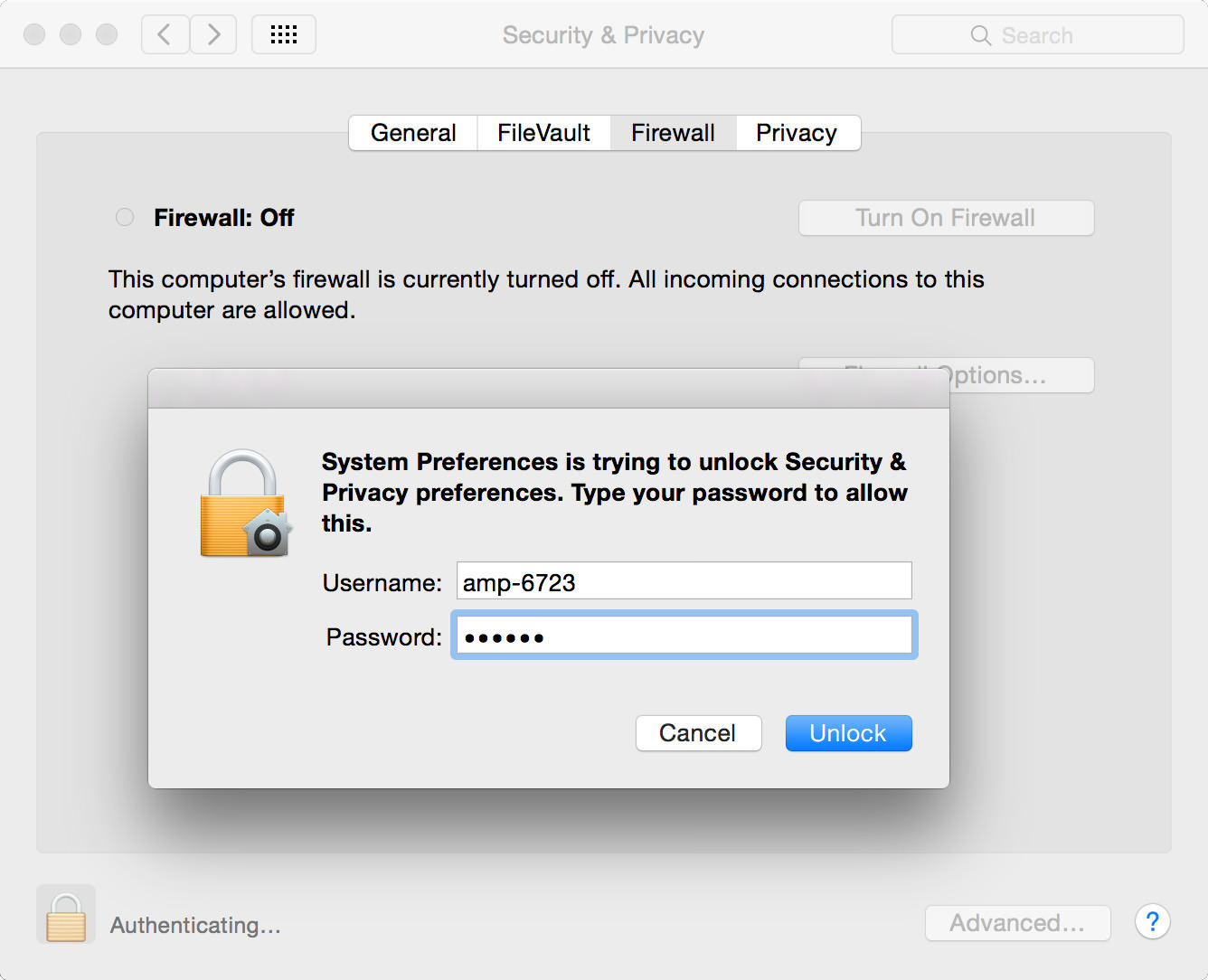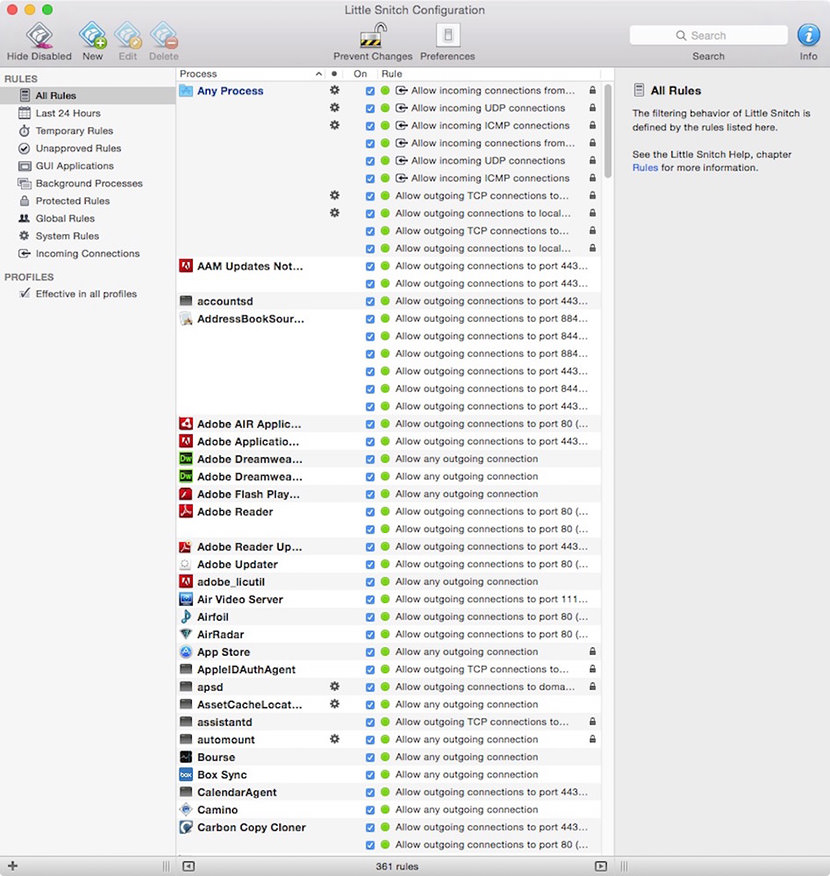- I had this exact same issue where Little Snitch detected external AirPlayXPCHelper traffic on port 7000 but treated it as internal traffic. What I mean is that even though I had all external traffic marked as deny, Little Snitch continued to prompt me on each connection attempt until I set it to deny local traffic (just for testing purposes), obviously I do not want to deny local traffic on.
- Jun 29, 2018 Little Snitch is a popular Mac app that detects outbound connections and lets you set up rules to block those connections. Once installed, Little Snitch monitors your internet traffic and every time it detects an outbound connection, for example, Adobe Reader trying to access the internet.
Just grab the output and copy/paste into Little Snitch. The script is written to block access to any process, any port. You can also delete those lines and it will only block Mail. Or use the options to enter any process, port or protocol you want to block. Block all IPv4 traffic when VPN is disconnected #285. (if it does), you can use a firewall like Little Snitch to block traffic on unsecured networks.
I use a PC at work and because it's the businesses internet I'm pretty careful about what I do/don't do not it.Mar 15, 2020 Little Snitch 4.5.2 Crack is the fabulous software that comes with the authority to assist to keep your Mac protected by scrutinizing the connections.This is a powerful application that allows you to control the inbound plus outbound traffic. Little Snitch purifies and expands this friendly firewall. Jan 03, 2020 – As I understood, the built-in firewall can also block certain apps. What is the advantage of Little Snitch or Hands off? – Is the feature of restricting specific url’s special to them? Or is the built-in firewall also capable of this? It would be great if you could add these comparison points to your article:) Best, Phil.
I use lists (most are free) are iblocklist.com and add them to programs like peerblocker - p2p lists, governments lists, pedophile lists.
They are update daily and its something Little Snitch really needs to work into the application.
When downloading from p2p, wether it be movies, or music there are some people you don't want to have any connection with, not the mention the people who are trolling for IP addresses. Allot of other Windows based (if not all) security programs are using some type of peer block - the popular MalwayreBytes Anti-Malware is constantly flashing when I'm downloading a new release of peers it has blocked.
If there is already a work around for this I would love to use it - if not we should see what we can do to help LittleSnitch work this into their next release!!!
Your Mac is a Net whisperer; a sleep talker; a teller of tales; a spreader of information. It's always sending messages to unseen servers while you go about your daily work. How do you keep tabs on and take control of what your Mac is talking to? Objective Development's $45 Little Snitch is the ticket to truly understanding and managing who your Mac makes contact with.

Little Snitch
Price: $45+ for a new copy; $25+ for an upgrade
Bottom line: Little Snitch is not only a great firewall application, it's educational and fun to use.
The Good
- Does more than the built-in firewall
- Has three different modes for more specific controls
- The Map lets you see where all the traffic is coming to and going from.
- Customizable features
The Bad
- Buying more than one license can get pricey.
Mind this chatter
Little Snitch is a firewall application and, as you may know, your Mac has a built-in firewall that you can turn on and use to quietly block unauthorized incoming network connections. So why buy a separate app if you already have something built-in? The answer is simple: Little Snitch does more than just block or allow incoming network connections. It gives you detailed information on all your network communication, whether it's from the outside world coming into your Mac or it's being sent from your Mac to anywhere on the internet.
Chatter from your Mac isn't all bad. In fact, most of it is good and necessary. Your Mac regularly checks the App Store to make sure your apps and OS are up to date. You stream music and movies from iTunes, Netflix, Hulu, and Pandora. You send and receive email, messages, and files all as a part of your normal work and play.
However, every web page you connect to also talks to ad servers and every app you open may also send information about you, your Mac, and about the app itself back to the company that created it. Little Snitch logs all this information and lets you look at it, see what the communication is about, and choose when or whether you want to allow your Mac to make that communication in the future.
Simple is as simple does
Little Snitch offers three modes of operation:
- Alert Mode
- Silent Mode—Allow Connections
- Silent Mode—Deny Connections
By default, Little Snitch uses Silent Mode—Allow Connections, which behaves just like Apple's built-in firewall does, which is to say that it assumes any application on your Mac that is properly signed is allowed to send and receive data at will. It also tracks every connection, while allowing all network traffic to freely enter and exit your Mac, so you can look at those connections and decide whether or not you want to make that connection in the future. This mode is the best choice for most users.
Alert Mode asks you to make a choice each time an application attempts to make a connection to the Internet. Once you make a choice, Little Snitch remembers your choices and allows or denies that connection in the future. Initially, if you're just starting to use Little Snitch, this can feel more like Annoying Mode, as you'll need to approve or deny every network connection attempt.
Silent Mode—Deny Connections is designed for situations where you want to create specific rules about which connections you will allow. Any connections you have not created an explicit rule for will be denied without asking for your approval.
The all seeing eye
The fun begins once Little Snitch is installed. A small menu item appears on the top of your screen and displays a small gauge setting so you know when you're sending and receiving network traffic. Click that menu and you'll see options to change modes and items for Little Snitch's Network Monitor, Rules, and Preferences.
Open the Network Monitor and a new window will open displaying a map of the world centered on your current location with arcs of network traffic traveling from your Mac to various locations throughout the world. A sidebar displays a list of applications sending and receiving traffic. Selecting one of those apps highlights where your traffic is going on the map. Another sidebar on the right displays a Connection Inspector which you use to view general and detailed information about data being sent with specific information about the application selected and why it might be sending or receiving information.
While viewing the Map or using Little Snitch's rules window you can select different apps and processes and use a small switch to allow or deny network traffic by flipping a small Rule Management switch.
Lockdown by location
Little Snitch has a multitude of customizable features, but one of my favorites is Automatic Profile Switching (APS), which allows you to create filtering profiles based on the network you're connected to. Want to be invisible when you're at Starbucks? No problem, you can create a profile for that. Not as worried when you're on your home network? You can create a profile for that. When you hop on a network APS detects where you are and automatically changes your Little Snitch profile to match your settings for the network you're on.
The ultimate lockdown
I wouldn't normally think of a firewall as something fun. It's business, pal. Just business. But that's not true of Little Snitch. Not only is it a great firewall application, it's educational and super fun to use. If you need something more than Apple's built-in firewall or if you need better insight into which applications are sending information from your Mac to servers on the Internet, Little Snitch is the best app I've seen, which makes it the best app for you.
Who goes there?

Hardware? Software? No-ware? How do you make sure your Mac's locked down and keeping your secrets to itself? Sound off in the comments below.
Keep yourself secure on the web
Main
We may earn a commission for purchases using our links. Learn more.
❤️ healthA story about me, two Apple Watches, and five lost years
Block Ipv4 On Little Snitch Lyrics
So I bought another Apple Watch. Here’s the story!